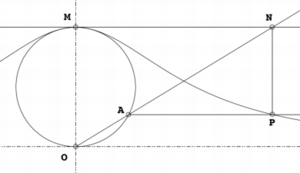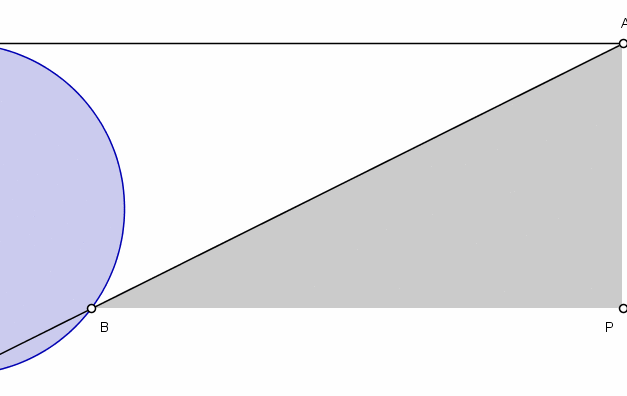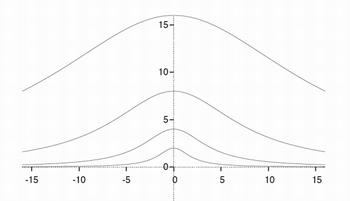
Witch of Agnesi
Encyclopedia
In mathematics
, the witch of Agnesi (a.ˈɲe.zi), sometimes called the witch of Maria Agnesi
is the curve defined as follows.
 Starting with a fixed circle, a point O on the circle is chosen. For any other point A on the circle, the secant line OA is drawn. The point M is diametrically opposite O. The line OA intersects the tangent of M at the point N. The line parallel to OM through N, and the line perpendicular to OM through A intersect at P. As the point A is varied, the path of P is the witch.
Starting with a fixed circle, a point O on the circle is chosen. For any other point A on the circle, the secant line OA is drawn. The point M is diametrically opposite O. The line OA intersects the tangent of M at the point N. The line parallel to OM through N, and the line perpendicular to OM through A intersect at P. As the point A is varied, the path of P is the witch.
The curve is asymptotic
to the line tangent to the fixed circle through the point O.
 Suppose the point O is the origin, and that M is on the positive y-axis.
Suppose the point O is the origin, and that M is on the positive y-axis.
Suppose the radius of the circle is a.
Then the curve has Cartesian equation
Note that if a=1/2, then this equation becomes rather simple:
Parametrically, if is the angle between OM and OA, measured clockwise, then
is the angle between OM and OA, measured clockwise, then
the curve is defined by the equations
Another parameterization, with being the angle between OA and the x-axis, increasing anti-clockwise is
being the angle between OA and the x-axis, increasing anti-clockwise is

which is the same as that of the generating circle (diameter = 2a).
in 1630. In 1703, Guido Grandi
gave a construction for the curve. In 1718 Grandi suggested the name 'versoria' for the curve, the Latin term for sheet
, the rope which turns (adjusts the trim of) the sail, and used the Italian word for it, 'versiera', a hint to sinus versus that appeared in his construction.
In 1748, Maria Agnesi
published her famous summation treatise Instituzioni analitiche ad uso della gioventù italiana, in which the curve was named according to Grandi, 'versiera'. Coincidentally, the contemporary Italian word 'Aversiera'/'Versiera', derived from Latin 'Adversarius', a nickname for Devil
, "Adversary of God", was synonymous with "witch". Probably for this reason Cambridge professor John Colson
mistranslated the name of the curve thusly. Different modern works about Agnesi and about the curve suggest slightly different guesses how exactly this mistranslation happened. Struik
mentions that:
On the other hand, Stephen Stigler
suggests that Grandi himself "may have been indulging in a play on words".
The Witch of Agnesi is also a fiction novel by Robert Spiller, in which a teacher gives a version of the history of the term.
Mathematics
Mathematics is the study of quantity, space, structure, and change. Mathematicians seek out patterns and formulate new conjectures. Mathematicians resolve the truth or falsity of conjectures by mathematical proofs, which are arguments sufficient to convince other mathematicians of their validity...
, the witch of Agnesi (a.ˈɲe.zi), sometimes called the witch of Maria Agnesi
Maria Gaetana Agnesi
Maria Gaetana Agnesi was an Italian linguist, mathematician, and philosopher. Agnesi is credited with writing the first book discussing both differential and integral calculus. She was an honorary member of the faculty at the University of Bologna...
is the curve defined as follows.

The curve is asymptotic
Asymptote
In analytic geometry, an asymptote of a curve is a line such that the distance between the curve and the line approaches zero as they tend to infinity. Some sources include the requirement that the curve may not cross the line infinitely often, but this is unusual for modern authors...
to the line tangent to the fixed circle through the point O.
Equations

Suppose the radius of the circle is a.
Then the curve has Cartesian equation
-
 .
.
Note that if a=1/2, then this equation becomes rather simple:
Parametrically, if
 is the angle between OM and OA, measured clockwise, then
is the angle between OM and OA, measured clockwise, thenthe curve is defined by the equations
Another parameterization, with
 being the angle between OA and the x-axis, increasing anti-clockwise is
being the angle between OA and the x-axis, increasing anti-clockwise is
Properties

- The area between the Witch and its asymptote is four times the area of the fixed circle (i.e.,
 ).
).
- The volume of revolution of the Witch, about its asymptote, is
 .
.
- The centroidCentroidIn geometry, the centroid, geometric center, or barycenter of a plane figure or two-dimensional shape X is the intersection of all straight lines that divide X into two parts of equal moment about the line. Informally, it is the "average" of all points of X...
of the curve is at
-
 ,
,
which is the same as that of the generating circle (diameter = 2a).
History
The curve was studied by Pierre de FermatPierre de Fermat
Pierre de Fermat was a French lawyer at the Parlement of Toulouse, France, and an amateur mathematician who is given credit for early developments that led to infinitesimal calculus, including his adequality...
in 1630. In 1703, Guido Grandi
Guido Grandi
thumb|Guido GrandiDom Guido Grandi, O.S.B. Cam., was an Italian monk, priest, philosopher, mathematician, and engineer.-Life:...
gave a construction for the curve. In 1718 Grandi suggested the name 'versoria' for the curve, the Latin term for sheet
Sheet (sailing)
In sailing, a sheet is a line used to control the movable corner of a sail.- Fore-and-aft rigs:Fore-and-aft rigs comprise the vast majority of sailing vessels in use today, including effectively all dinghies and yachts. The sheet on a fore-and-aft sail controls the angle of the sail to the wind,...
, the rope which turns (adjusts the trim of) the sail, and used the Italian word for it, 'versiera', a hint to sinus versus that appeared in his construction.
In 1748, Maria Agnesi
Maria Gaetana Agnesi
Maria Gaetana Agnesi was an Italian linguist, mathematician, and philosopher. Agnesi is credited with writing the first book discussing both differential and integral calculus. She was an honorary member of the faculty at the University of Bologna...
published her famous summation treatise Instituzioni analitiche ad uso della gioventù italiana, in which the curve was named according to Grandi, 'versiera'. Coincidentally, the contemporary Italian word 'Aversiera'/'Versiera', derived from Latin 'Adversarius', a nickname for Devil
Devil
The Devil is believed in many religions and cultures to be a powerful, supernatural entity that is the personification of evil and the enemy of God and humankind. The nature of the role varies greatly...
, "Adversary of God", was synonymous with "witch". Probably for this reason Cambridge professor John Colson
John Colson
Johnathan "John" Colson was an English clergyman and mathematician, Lucasian Professor of Mathematics at Cambridge University.John Colson was educated at Lichfield School before becoming an undergraduate at Christ Church, Oxford, though he did not take a degree there...
mistranslated the name of the curve thusly. Different modern works about Agnesi and about the curve suggest slightly different guesses how exactly this mistranslation happened. Struik
Dirk Jan Struik
Dirk Jan Struik was a Dutch mathematician and Marxian theoretician who spent most of his life in the United States.- Life :...
mentions that:
On the other hand, Stephen Stigler
Stephen Stigler
Stephen Mack Stigler is Ernest DeWitt Burton Distinguished Service Professor at the Department of Statistics of the University of Chicago. His research has focused on statistical theory of robust estimators and the history of statistics...
suggests that Grandi himself "may have been indulging in a play on words".
The Witch of Agnesi is also a fiction novel by Robert Spiller, in which a teacher gives a version of the history of the term.
Sources
- "Witch of Agnesi" at MacTutor's Famous Curves Index
- "Cubique d'Agnesi" at Encyclopédie des Formes Mathématiques Remarquables (in French)
External links
- Witch of Agnesi by Chris Boucher based on work by Eric W. WeissteinEric W. WeissteinEric W. Weisstein is an encyclopedist who created and maintains MathWorld and Eric Weisstein's World of Science . He currently works for Wolfram Research, Inc.-Education:...
, The Wolfram Demonstrations Project. - The Witch of Agnesi - Mathforum.org Java applet




